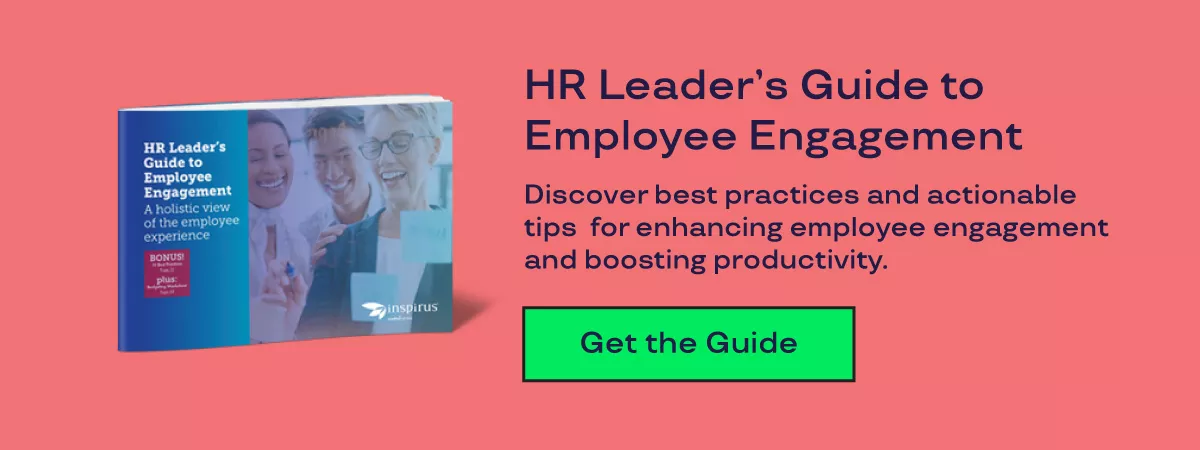
Overcoming HR Strategic Planning Challenges and Solutions
June 12, 2024
People are at the heart of just about any company, making human resources (HR) one of the most impactful departments for both business growth and employee relations.
As the economic landscape and needs of the modern workforce have evolved, so too have HR strategic plans and the challenges associated with successful execution of those plans.
HR managers are tasked with a delicate balancing act, aligning an organization's immediate needs like talent acquisition and retention with long-term key objectives like growth and innovation. The multifaceted nature of HR means that it both guides the organization toward its goals and drives company culture.
It’s a complex puzzle. Here are some ways to tackle the most pressing HR strategy challenges and drive meaningful change.
HR Strategic Planning
HR strategic planning is the deliberate process of aligning human resource practices with overarching business objectives, ensuring that the organization's most valuable assets—its people—are supported in driving sustainable growth. That means HR is involved in much more than just operational or administrative tasks.
For instance, think about all that’s involved in talent management from an HR perspective. This involves a systematic assessment of current workforce capabilities, identification of future talent needs and strategies to bridge the gap between the two. On top of that, the human resource planning process needs to nurture employee growth, engagement and satisfaction while fueling organizational success in the long term.
Components of an Effective HR Strategic Plan
An effective strategic HR plan involves several key components, each playing a crucial role in shaping the organization's talent management approach. These components include:
- Workforce Planning: Anticipating future skill requirements and aligning talent acquisition and development strategies accordingly.
- Talent Management: Implementing processes for recruiting, onboarding, training and retaining employees to maximize their potential and contribution to organizational goals.
- Employee Engagement: Cultivating a positive work environment where employees are motivated, empowered and committed to achieving organizational objectives. This, in particular, is a priority for many organizations right now.
- Performance Management: Establishing clear goals and providing regular feedback, in addition to recognizing and rewarding high performance to drive continuous improvement.
- Continuous Improvement: Prioritizing feedback loops and ways for employees to provide input on their experiences through regular surveys and a culture of open communication.
HR strategic planning is not a static process, but rather a dynamic, iterative journey where HR leaders continuously assess and adapt to ensure that their organizations remains agile.
Challenges in HR Strategic Planning
Navigating the complexities of HR strategic planning is a formidable task for organizations seeking to align their strategic human resources and capital strategies with overarching business objectives. From rapid technological advancements to shifting workforce dynamics, HR leaders encounter numerous challenges that demand strategic foresight and innovative solutions.
Rapid Technological Advancements
Technology is reshaping HR practices at an unprecedented pace. Take AI, for example: up to 60% of enterprise organizations plan to adopt a responsible AI framework for their HR technology by 2025, according to Gartner. And that changes how all kinds of work is done, impacting the skillsets that hiring managers are looking for from employees and how hiring processes are conducted.
It requires a concerted effort from organizational leaders to responsibly navigate the emergence of new technologies, particularly when it comes to AI.
Changing Workforce Dynamics
The workplace looks very different today than it did even just a few years ago. The work-from-home movement during COVID times fundamentally and permanently altered work models. Suddenly, it was possible for entire organizations to work remotely – and that’s not going away any time soon.
While many employees have gone back to working in person in some capacity, nearly three-quarters (74%) of U.S. companies currently use or plan to adopt a permanent hybrid work model, according to Zippia research.
The rise of remote work has profound implications for strategic planning. While there are many benefits to having remote or hybrid employees, it also presents challenges. Human interaction and connection are more important than ever, particularly when teams are geographically dispersed.
HR leaders must adapt policies and practices to support remote teams effectively, in order to maintain communication and collaboration, preserve organizational culture and ensure employees’ well-being and productivity.
Talent Acquisition and Retention
Organizations face intense competition to attract and retain top talent, particularly in industries where skilled professionals are in demand. Proactive talent acquisition and retention is essential.
In fact, just over a quarter of employees (26%) said they were likely to change jobs in the next year, according to a survey by PwC. Employee turnover poses significant challenges for organizations, impacting everything from productivity to morale to strategic planning efforts.
To combat this, HR departments everywhere are deploying innovative strategies for attracting and retaining top talent – including offering more flexible work schedules, perks and other rewards, in addition to more competitive salaries.
Regulatory Compliance
A key area of responsibility for HR leaders within organizations is establishing and maintaining a safe, healthy, fair and equitable workplace environment for employees. From a business strategy and a legal perspective, this means ensuring adherence to labor laws and regulations – also known as HR compliance.
These are some of the most common regulatory compliance issues organizations inadvertently come up against:
- Job listings that aren’t inclusive
- Interview questions about protected class information (e.g., age, parental status, race, religion)
- Incomplete documentation of eligibility to work
- Worker misclassification (employees versus contractors, for instance)
Data Management and Analytics
Knowledge is power. For HR leaders, the right data and analytics can provide important insight into the health of their company’s culture, employee happiness and the success of strategic initiatives.
However, along with the opportunities presented by data analytics comes a host of challenges, particularly in terms of data privacy and security. Ensuring employees’ confidentiality and data security is a non-negotiable for maintaining trust and safeguarding sensitive information – and, in many cases, it’s a legal mandate.
Overcoming Challenges and Best Practices
A combination of innovative solutions and best practices tailored to the unique needs of your organization can help address the most common challenges of the strategic HR planning process. Here’s where to start.
Solution #1: Leveraging Technology for Strategic Advantage
Embracing technology can help HR gain a strategic advantage. For example, an employee recognition platform like Inspirus supports workplace appreciation efforts, ensuring that employees feel valued.
Plus, using the right technological solutions streamlines administrative tasks, allowing HR professionals to focus on more important and strategic initiatives.

AI and machine learning tools with predictive analytics can also support decision-making processes. Make sure to provide training and upskilling for HR professionals, in addition to investing in any new AI technology, so they have the knowledge and skills needed to use these tools effectively.
Solution #2: Cultivating a Flexible and Inclusive Culture
A flexible and inclusive culture is good for employees, the organization as a whole and your clients. LinkedIn research found that inclusive teams are 35% more productive and diverse groups make better decisions 87% of the time, for example.
- Prioritize diversity and inclusion initiatives: This can include unconscious bias training, employee resource groups, mentorship programs and diversity recruitment initiatives.
- Embrace flexible work policies: Establish policies that accommodate the changing needs of the workforce, such as flexible working hours, remote work options and outcome-focused performance metrics.
- Focus on employee engagement: Ensure that all employees – whether remote, hybrid or in-person – feel connected and valued with engagement strategies like team-building activities, regular check-ins and a culture of open communication.
Solution #3: Strategic Talent Management
Effective talent management requires a holistic approach to employee satisfaction and retention. Consider the following strategies:
- Implement a rewards and recognition program: Develop a comprehensive rewards and recognition program that celebrates employee achievements and ensures all employees feel valued for their contributions.
- Emphasize "total compensation": Beyond monetary compensation, offer a comprehensive package that includes benefits such as better work-life balance, flexible work arrangements, wellness programs and other perks.
- Invest in learning and professional development: Provide employees with opportunities for continuous learning and growth through training programs, skill development initiatives and access to resources that support career advancement.
Solution #4: Proactive Compliance Management
Proactive compliance management is essential for mitigating legal exposure and upholding ethical standards within any organization. Ensure proper documentation processes are in place that adhere to both internal policies and external labor laws – and, importantly, that these processes are being consistently followed.
It’s also worth investing in compliance training for HR staff to ensure they are supported in navigating complex regulatory environments effectively and are staying abreast of any policy changes.
Solution #5: Data-Driven Decision Making
Data-driven decision-making empowers the strategic HR and team to make informed choices that drive organizational success. Establish metrics and key performance indicators (KPIs) to gauge progress and identify areas for improvement for all initiatives.
For instance, use employee feedback surveys to keep track of sentiment, satisfaction and happiness. Continuous monitoring and evaluation of your HR initiatives and strategies ensure they remain aligned with organizational goals and responsive to changing market dynamics, driving continuous improvement and innovation.
Additionally, advancements in AI are continuing to shape the HR decision-making landscape. Using AI to understand historical trends and provide new insights that help further strategy is becoming increasingly common. In fact, 60 percent of enterprise organizations are expected to start using a responsible AI framework for their HR technology by 2025.
Embrace Innovation and Strategic Thinking in HR Planning
Navigating the challenges of today’s workplaces isn’t easy, but it’s unavoidable if an organization is to survive and thrive. HR strategic planning in particular requires a proactive approach and innovative solutions.
By staying informed, adaptable and forward-thinking, HR leaders can drive meaningful change and create workplaces where employees flourish. To learn more about enhancing employee engagement and navigating the complexities of HR strategic planning, get The HR Leader’s Guide to Employee Engagement.





